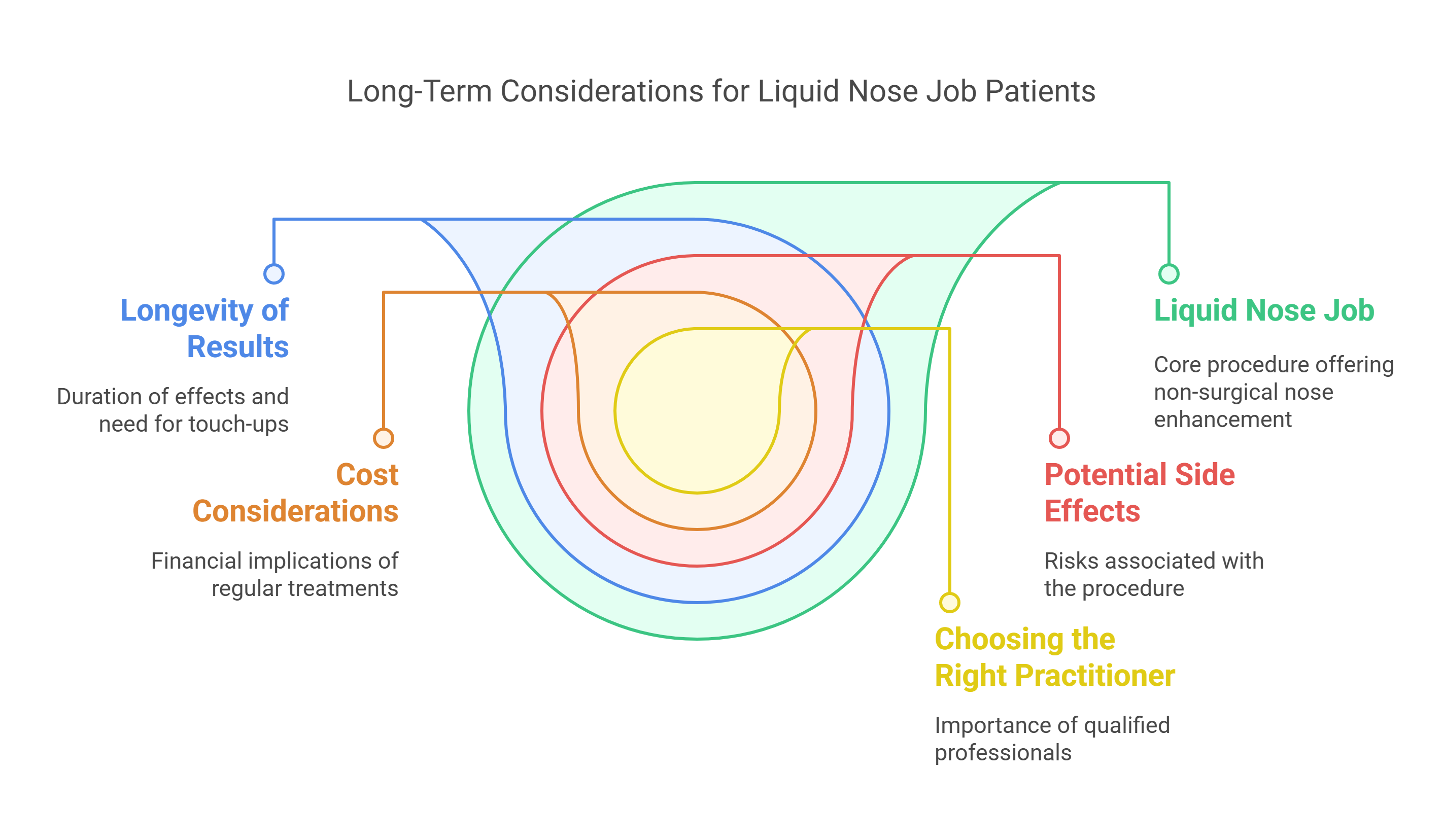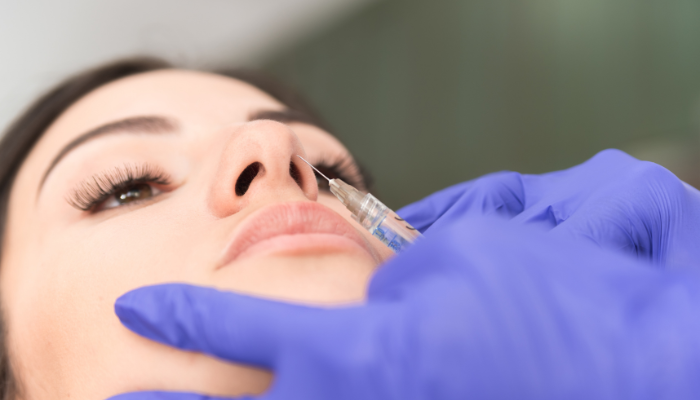Considering a liquid nose job? It’s a popular choice for those wanting to enhance their nose without going under the knife.
However, just like any cosmetic procedure, it comes with its own set of side effects and risks. Knowing what to expect can help you make an informed decision about whether this procedure is right for you.
Key Takeaways
- Common side effects include swelling and redness at the injection site.
- Long-term effects of fillers can vary, with some patients needing touch-ups.
- Proper aftercare is crucial to manage any side effects effectively.
- Choosing a qualified practitioner can reduce risks associated with injections.
- Liquid nose jobs are temporary, so consider your long-term aesthetic goals.
Understanding Liquid Nose Job Side Effects
It’s a pretty popular way to tweak your nose without going under the knife. But, like any cosmetic procedure, it’s good to know what you’re getting into. Let’s have a look at the side effects you might experience.
Common Side Effects to Expect
Alright, let’s talk about what’s normal. After a liquid nose job, it’s pretty common to see some redness and swelling around the injection sites. You might also feel a bit tender to the touch.
Bruising is another thing that can happen, but it really depends on your skin and how your body reacts. These things usually clear up within a week or so. It’s all part of the adjustment process, so don’t panic if you see any of this.
Long-Term Effects of Fillers
Now, what about the long haul? Fillers aren’t permanent, so the effects of a liquid nose job will fade over time. Usually, we’re talking months, maybe up to a year or two. As the filler breaks down, your nose will gradually go back to its original shape.
Some people also worry about the filler migrating or causing changes to the skin over time, but that’s pretty rare. Still, it’s something to keep in mind.
Managing Side Effects Effectively
Okay, so you’ve got some swelling and bruising. What can you do?
- Ice packs are your best friend for the first day or two. Just wrap them in a cloth and apply them to the area for about 15-20 minutes at a time.
- You can also take over-the-counter pain relievers like paracetamol or ibuprofen to help with any discomfort.
- Try to avoid touching or putting pressure on your nose for a while.
If anything seems off or gets worse, don’t hesitate to give your practitioner a call.
It’s important to remember that everyone’s experience is different. Some people breeze through the recovery with no problems, while others might have a bit more to deal with. The key is to be prepared, follow your practitioner’s instructions, and know when to seek help if you need it.
Potential Risks Associated with Liquid Nose Jobs
While liquid nose jobs offer a less invasive route to reshaping your nose, it’s important to be aware of the potential risks involved. It’s not all sunshine and rainbows, and being informed is key to making the right decision for you. Let’s have a look at some of the things that could go wrong.
Injection Complications
One of the primary risks stems from the injection process itself. If the filler is accidentally injected into a blood vessel, it can cause serious problems. This can disrupt the blood supply to the surrounding skin, potentially leading to tissue damage or even necrosis.
It’s not something to take lightly, and it highlights the importance of choosing a practitioner who really knows their stuff.
Allergic Reactions to Fillers
Although rare, allergic reactions to the fillers used in liquid nose jobs can occur. These reactions can range from mild redness and swelling to more severe symptoms requiring medical intervention.
It’s usually hyaluronic acid based, but you can still react. Before undergoing the procedure, it’s vital to discuss any known allergies with your practitioner and undergo a patch test if necessary. Better safe than sorry, right?
Impact on Facial Aesthetics
While the goal of a liquid nose job is to enhance facial aesthetics, there’s a risk that the results might not meet your expectations or could even negatively impact your overall appearance.
Overfilling or incorrect placement of the filler can lead to asymmetry, an unnatural look, or distortion of other facial features. It’s a good idea to have a detailed consultation with your practitioner to discuss your desired outcome and ensure they have a clear understanding of your facial anatomy.
It’s worth remembering that while liquid nose jobs can offer improvements, they aren’t suitable for everyone. If you’re looking for a dramatic change or have significant structural issues with your nose, surgical rhinoplasty might be a better option. Always weigh up the pros and cons before making a decision.
Post-Procedure Care for Liquid Nose Jobs
Now, it’s time to make sure you look after your new nose so you can get the best results. It’s not complicated, but following these steps will really help.
Immediate Aftercare Tips
Right after the procedure, there are a few things you should keep in mind. It’s all about being gentle and avoiding anything that could disrupt the filler.
- Avoid touching your nose. I know it’s tempting, but try not to prod or poke it for at least the first few hours. The filler is still settling, and you don’t want to move it around.
- Skip the makeup. Give your skin a break and avoid applying makeup on or around your nose for 24 hours. This minimises the risk of irritation or infection.
- No heavy exercise. Avoid activities that cause excessive sweating for at least 24 hours. This includes hitting the gym or doing anything too strenuous.
Think of it like this: you’ve just had a little bit of work done, and your nose needs time to settle. Treat it with care, and you’ll be much happier with the outcome.
Signs of Complications to Watch For
While liquid nose jobs are generally safe, it’s important to keep an eye out for any signs of complications. Knowing what to look for means you can act quickly if needed.
- Increased pain or swelling that doesn’t subside after a few days.
- Redness or warmth around the injection site, which could indicate an infection.
- Any signs of an allergic reaction, such as itching, rash, or difficulty breathing.
When to Contact Your Practitioner
It’s always better to be safe than sorry. If you experience any of the complications mentioned above, or if you have any other concerns, don’t hesitate to contact your practitioner.
- If you’re unsure about something, just ask. Your practitioner is there to support you throughout the process.
- Keep their contact information handy so you can reach them easily if needed.
- Don’t wait. If something doesn’t feel right, get in touch as soon as possible.
Comparing Liquid Nose Jobs to Surgical Options
Benefits of Non-Surgical Procedures
So, you’re weighing up your options, eh? Liquid nose jobs, or non-surgical rhinoplasty, have become quite popular, and for good reason. One of the biggest draws is the minimal downtime. You can often pop in for a procedure and be back to your normal routine the very next day.
Here’s a quick rundown of the benefits:
- Reduced risk compared to surgery.
- Faster recovery period.
- Lower cost.
- Reversible results (if hyaluronic acid fillers are used).
Limitations of Liquid Nose Jobs
Liquid nose jobs aren’t a magic bullet. They’re great for minor tweaks, like smoothing out a dorsal hump or lifting the tip of your nose. But if you’re after a significant change, like reducing the size of your nose or correcting breathing problems, then Surgical Nose Job is probably the way to go.
Liquid rhinoplasty is great for small adjustments, but it can’t achieve the same dramatic results as a surgical rhinoplasty. It’s important to understand these limitations before making a decision.
Cost Considerations
Okay, let’s talk money. Liquid nose jobs are generally cheaper upfront than surgical rhinoplasty. But remember, the results aren’t permanent. You’ll need touch-ups every 6-18 months, which can add up over time. Surgical rhinoplasty, on the other hand, is a one-off cost, but it’s a bigger investment initially.
Here’s an approximate cost:
| Procedure | Average Cost (GBP) | Longevity |
|---|---|---|
| Liquid Nose Job | £300 – £500 | 6-18 months |
| Surgical Rhinoplasty | £4,000 – £7,000 | Permanent (often) |
Ultimately, the best option depends on your budget, desired results, and how much you value permanence versus reversibility.
Choosing the Right Practitioner for Your Liquid Nose Job
Finding a professional practitioner for your liquid nose job is, like, super important. It’s not just about getting a good price; it’s about your face, your health, and your confidence.
You want someone who knows what they’re doing, someone you can trust, and someone who understands what you’re hoping to achieve. You need to do your research and make sure they’re a good fit for you.
Importance of Qualifications and Experience
Okay, so first things first: qualifications. You need to make sure the person doing your liquid nose job is actually qualified to do it. Check their credentials, see where they trained, and make sure they’re registered with the appropriate medical bodies.
Don’t be afraid to ask for proof of their qualifications. Experience is also key. Someone who’s performed loads of these procedures is going to be much better equipped to handle any complications that might arise.
Questions to Ask During Consultation
Consultations are your chance to grill the practitioner and see if they’re the right fit. Here are a few questions you might want to ask:
- How many liquid nose jobs have you performed?
- Can I see some before-and-after photos of your previous patients?
- What type of filler do you use, and why?
- What are the potential risks and complications of the procedure?
- What happens if I’m not happy with the results?
It’s also a good idea to ask about their approach to aftercare. A good practitioner will provide you with detailed instructions on how to care for your nose after the procedure and will be available to answer any questions you might have.
Understanding the Procedure
Before you go ahead with the procedure, make sure you fully understand what it involves. Ask the practitioner to explain the process in detail, including what to expect during and after the treatment. It’s also important to have realistic expectations.
A liquid nose job can make subtle changes to the shape of your nose, but it’s not going to give you a completely new nose. If you’re unsure about anything, don’t be afraid to ask for clarification. It’s your face, after all, and you deserve to be fully informed.
Long-Term Considerations for Liquid Nose Job Patients

Frequency of Touch-Ups
You’re probably loving the results. But let’s be real, it’s not a permanent fix. Fillers do their thing for a while, but eventually, your body absorbs them. This means you’ll need touch-ups to maintain that perfect nose contour.
How often? Well, it varies. Some people find they need a top-up every six months, while others can go a year or more. It really depends on the type of filler used and how quickly your body metabolises it.
Potential for Skin Changes
Okay, this is something not everyone talks about, but it’s worth knowing. Repeated filler injections can, over time, potentially lead to changes in your skin. We’re talking about things like skin laxity (where your skin loses some of its elasticity) or even the formation of scar tissue. It’s not super common, but it’s a possibility.
That’s why it’s so important to go to a practitioner who knows their stuff and uses the right techniques. They can help minimise these risks. Also, it’s worth noting that some doctors advise against repeated liquid nose jobs after the initial one wears off, due to potential damage to skin and blood vessels.
Evaluating Results Over Time
Right, so you’ve had your liquid nose job, and you’re thrilled. But it’s not just about the immediate wow factor. It’s important to keep an eye on how things are settling over the months.
- Does the filler migrate?
- Is the shape still what you wanted?
Sometimes, the filler can shift a bit, and you might need a slight tweak to get things back on track.
It’s a good idea to take photos regularly so you can compare and see how your nose is changing over time. This will help you and your practitioner make informed decisions about future treatments. Plus, it’s just nice to have a record of your journey!
Here’s a little checklist to help you evaluate your results:
- Take photos every month for the first six months.
- Note any changes in shape or contour.
- Discuss any concerns with your practitioner at your follow-up appointments.
Alternatives to Liquid Nose Jobs
So, you’re exploring options for tweaking your nose but maybe a liquid nose job isn’t quite the right fit? No worries, there are definitely other avenues to consider. Let’s have a look at what else is out there.
Surgical Rhinoplasty Options
Okay, let’s talk surgery. A surgical rhinoplasty is the traditional nose job, and it’s still a very popular choice for good reason. It offers permanent and often more dramatic results than non-surgical options. If you’re looking to significantly reshape your nose, correct breathing problems, or address structural issues, surgery might be the way to go.
The downside? It’s more invasive, involves a longer recovery period, and comes with a higher price tag. But for some, the long-term benefits outweigh these factors.
Other Non-Surgical Treatments
If surgery sounds too intense, you’re in luck! The world of aesthetics is constantly evolving, and there are other non-surgical options to explore. While nothing else quite replicates the effect of fillers in the nose, some treatments can improve the overall appearance of your face, which can indirectly impact how your nose looks.
Think about things like:
- Skin Resurfacing: Treatments like laser resurfacing or chemical peels can improve skin texture and tone, making your nose appear more refined.
- Chin Augmentation: Believe it or not, a weak chin can make your nose look larger. Augmenting the chin can bring balance to your facial profile.
- Jawline Contouring: Similar to chin augmentation, defining the jawline can create a more harmonious facial structure, subtly altering the perception of your nose.
Combining Treatments for Best Results
Sometimes, the best approach involves a combination of treatments. For example, you might consider a liquid nose job to address a dorsal hump, followed by skin resurfacing to improve the skin quality on your nose.
Or, perhaps a subtle chin augmentation alongside a non-surgical nose job to achieve overall facial balance.
It’s all about finding the right combination that addresses your specific concerns and helps you achieve your desired aesthetic outcome. Consulting with a skilled and experienced practitioner is key to determining the most effective treatment plan for you.
Conclusion
While a liquid nose job can be an appealing option for those looking to enhance their nose without surgery, it’s important to be aware of the potential side effects. From minor swelling and bruising to more serious risks, understanding what to expect can help you make an informed decision.
If you’re considering this procedure, consult with a qualified professional who can guide you through the process and address any concerns you may have. Remember, your safety and satisfaction should always come first.
Frequently Asked Questions
What are the common side effects of a liquid nose job?
After a liquid nose job, you might notice some redness, swelling, or bruising around the injection site. These effects usually go away within a few hours to a few days.
How long do the results of a liquid nose job last?
The results from a liquid nose job can last from six months to a year, depending on the type of filler used and individual factors.
Can a liquid nose job fix breathing issues?
No, a liquid nose job cannot fix any breathing problems. It is only for cosmetic changes to the nose’s appearance.
What should I do if I notice complications after the procedure?
If you see signs of complications, like severe swelling or unusual pain, you should contact your practitioner right away for advice.
Are there any long-term risks associated with liquid nose jobs?
Yes, there can be long-term risks, such as skin changes or the need for frequent touch-ups, as the fillers are not permanent.
How do I choose the right practitioner for a liquid nose job?
Look for a qualified practitioner with experience in non-surgical procedures. Ask them about their qualifications and previous work during the consultation.






